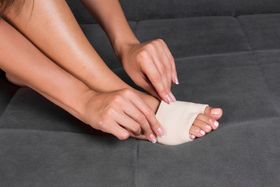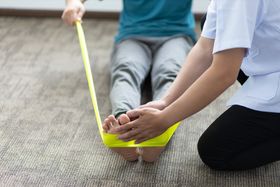How Can Heel Pain From Standing Be Prevented?
Heel pain is a common problem for people who stand for long periods. Learn more on how you can prevent and manage this pain.
Published June 29, 2022
Heel pain is a common problem in people that have to stand for long hours. It can be disconcerting and reduce efficiency at work. While heel pain may be caused by a variety of things, heel pain may also occur because people stand for long periods.
When standing, the feet and leg muscles continue to generate tension to keep you balanced. Over time, this can cause soreness in your muscles. Also, standing reduces circulation and oxygen supply to the feet, further increasing pain. Again, a condition like flat feet can worsen heel pain.
What to Do About Heel Pain When Standing
Heel pain while standing may be inevitable because of work or lifestyle. It is important to know why your heels hurt and what you will need to do to manage the pain. Some of the things that you can do to manage heel pain include:
- Rest Get off your feet whenever possible, relax and elevate your feet. If the pain persists, you can either use NSAIDs, or ice to relieve the pain and control inflammation.
- Massage To aid relaxation of lower limb muscles and relieve pain off your feet.
- Exercises Exercises for heel pain should include stretching and strengthening techniques. Stretching before and after periods of long-standing reduces the level of pain from standing. Likewise, strengthening the muscles builds them up so they can support more tension. Finally, endurance exercises will help prevent easy muscle fatigue.
- Use of custom orthotics These provide additional cushioning and comfort for the feet, and they relieve pressure and tension.
- Wear the right footwear Avoid wearing tight-fitting shoes with limited toe space.
Should You See a Doctor for Heel Pain?
The recovery from heel pain depends on the severity and the promptness of intervention. Generally, relieving heel pain should resolve with rest and conservative treatment. However, if these methods do not relieve your heel pain, please visit a doctor, so that they can assess your condition. The doctor will diagnose the cause of the pain and prescribe the most appropriate treatment.
Related Articles

The Effectiveness of Cortisone Injections for Plantar Fasciitis
Dr. Pooja Gajare
December 12, 2024

Treating Metatarsalgia With Insoles and Other Orthotic Devices
Janik Sundstrom
January 30, 2024

Is Plantar Fibroma Surgery Even Worth It?
Babafemi Adebajo
August 17, 2022

Recommended Treatments for Reversible Peripheral Neuropathy
Babafemi Adebajo
August 16, 2022

Best Insoles for Claw Toe
Babafemi Adebajo
May 14, 2025
Related Posts
Janik Sundstrom
Custom Orthotics for Heel Pain—2025 Review
Babafemi Adebajo
How to Avoid the Sharp Heel Pain When Running
Janik Sundstrom
Heel Pain When Stretching: Causes and Treatments
Janik Sundstrom
4 Tips for Relieving Heel Pain During Pregnancy
Babafemi Adebajo
Heel Bursitis Home Treatment Guide
Babafemi Adebajo
Massages for Heel Spurs: Helpful Tips and Techniques
Babafemi Adebajo
How to Massage Plantar Fasciitis: Best Techniques and Tools
Staff Writer



